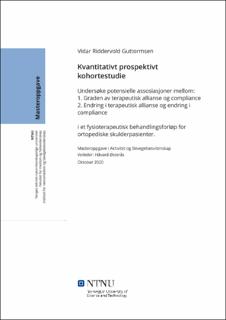| dc.contributor.advisor | Østerås, Håvard | |
| dc.contributor.author | Guttormsen, Vidar Riddervold | |
| dc.date.accessioned | 2021-09-25T16:27:29Z | |
| dc.date.available | 2021-09-25T16:27:29Z | |
| dc.date.issued | 2020 | |
| dc.identifier | no.ntnu:inspera:67456512:13408837 | |
| dc.identifier.uri | https://hdl.handle.net/11250/2783097 | |
| dc.description.abstract | Bakgrunn: Terapeutisk allianse (TA) blir betraktet som å være de interaksjonene som oppstår mellom terapeut og pasient i en behandlingssituasjon. TA kan forstås som en felles forståelse og enighet for ønsket målsetting i behandling og hvilke behandlingsverktøy som skal iverksettes. I tillegg er det emosjonelle og menneskelige båndet mellom den som søker hjelp og den som yter hjelp en viktig del av TA. I medisinske og psykologiske vitenskapelige studier er det funnet klare assosiasjoner mellom TA og compliance, samt behandlingsutfall. Det er imidlertid ikke blitt utført mange vitenskapelige studier som undersøker potensielle samvariasjoner mellom TA og compliance i fysioterapibehandling.
Hensikt / Problemstilling: Dette studiet ønsker å undersøke samvariasjoner mellom graden og endringen av terapeutisk allianse og compliance for ortopediske skulderpasienter som gjennomgår fysioterapibehandling.
Metode: Dette studiet er et prospektivt kvantitativt kohortstudie, som pågikk i en periode på 18 måneder. 9 fysioterapeuter tilknyttet private klinikker i Trøndelag med og uten HELFO driftstilskuddsavtale, og 30 pasienter med skulderplager deltok i studiet. Fysioterapeutens (N-STARB) og pasientens (N-STARP) opplevelser av terapeutisk allianse og compliance (RADMAT) ble målt 2, 8 og 12 uker etter oppstart ved bruk av standardiserte spørreskjema. Repeated measures ANOVA ble anvendt for å se om N-STARB, N-STARP og RADMAT hver for seg endret seg signifikant i løpet av behandlingen. Pearson r korrelasjonsanalyse med signifikansnivå p=0.05 ble benyttet for å analysere datamaterialet. Drop out var 9 pasienter (30%), samt at 3 fysioterapeuter (33%) ikke klarte å inkludere pasienter til studiet. Totalt ble 21 datasett inkludert for analyse og drøfting.
Resultat: Det ble ikke funnet signifikante samvariasjoner mellom pasientens opplevelser av graden og endringen av TA og compliance. Enkelte positive signifikante korrelasjoner med moderat styrke ble funnet mellom fysioterapeutens opplevelser av graden (0.48 < r < 0.6, p<0.05) og endringen (0.45 < r < 0.52, p<0.05) av TA og compliance. Repeated measures ANOVA viste at snittverdiene for scoreverdiene til RADMAT endret seg signifikant med - 3.24 poeng fra 2 uker til 12 uker (p=0.03). Snittverdiene for scoreverdiene til N-STARB og N-STARP hadde ingen signifikante endringer i behandlingen.
Diskusjon / Konklusjon: Funnene kan tolkes som en bekreftelse på tidligere utførte studier som har vist lignende samvariasjoner. God allianse i fysioterapibehandling for ortopediske skulderpasienter kan være en nødvendighet for å oppnå høy compliance og et positivt behandlingsutfall. Moderat drop out av fysioterapeuter og pasienter, lav N, manglende målinger av terapeutisk allianse og compliance for pasienter som droppet ut, potensielle takeffekter for anvendte måleverktøy og ingen styrkeberegning påvirker studiets validitet. Assosiasjonene mellom TA og compliance er ikke kontrollert for andre variabler som kan belyse og forklare kausalitet. | |
| dc.description.abstract | Background: Therapeutic alliance (TA) is considered to be the interactions that occur between the therapist and the patient in a treatment situation. TA can be understood as a mutual understanding and agreement for the desired treatment goal and which tools are to be implemented. In addition, the emotional and human bond between the person seeking help and the person providing help is an important part of TA. In medical and psychological scientific studies, clear associations have been found between TA and compliance, as well as treatment outcomes. However, not many scientific studies have been conducted examining potential covariations between TA and compliance in physiotherapy treatment.
Purpose of study: The study wants to map and investigate correlations between the degree and the change of therapeutic alliance and compliance for orthopedic shoulder patients undergoing physiotherapy treatment.
Method: This is a prospective quantitative cohort study, which lasted over a period of 18 months. 9 physiotherapists working at private clinics in Trøndelag with and without the HELFO agreement and 30 patients with shoulder pain participated in the study. The physiotherapist's (N-STARB) and patient's (N-STARP) experiences of therapeutic alliance and compliance (RADMAT) were measured 2, 8 and 12 weeks after start-up using standardized questionnaires. Repeated measures ANOVA was used to see if N-STARB, N-STARP and RADMAT each changed significantly during treatment. Pearson r correlation analysis with significance level p = 0.05 was used to analyze the data material. Drop out was 9 patients (30%) and 3 physiotherapists (33%) were unable to include patients in the study. A total of 21 data sets were included for analysis and discussion.
Results: No significant correlations were found between the patient's experiences of the degree and the change in TA and compliance. Some positive significant correlations with moderate strength were found between the physiotherapist's experiences of the degree (0.48 <r <0.6, p <0.05) and the change (0.45 <r <0.52, p <0.05) of TA and compliance. Repeated measures ANOVA showed that mean score values for RADMAT changed significantly with - 3.24 points from 2 weeks to 12 weeks (p = 0.03). Mean score values for N-STARB and N-STARP did not show a significant change during treatment.
Conclusion: The findings can be interpreted as a confirmation of previously performed studies that have shown similar covariations. A good alliance in physiotherapy treatment for orthopedic shoulder patients may be a necessity to achieve high compliance and a positive treatment outcome. Moderate drop out of physiotherapists and patients, low N, lack of measurements of therapeutic alliance and compliance for patients who dropped out, potential roof effects for the measurement tools used and no power calculation affect the validity of the study. The associations between TA and compliance have not been checked for other variables that can shed light on and explain causality. | |
| dc.language | | |
| dc.publisher | NTNU | |
| dc.title | Kvantitativt prospektivt kohortestudie
Undersøke potensielle assosiasjoner mellom:
1. Graden av terapeutisk allianse og compliance
2. Endring i terapeutisk allianse og endring i compliance
i et fysioterapeutisk behandlingsforløp for ortopediske skulderpasienter | |
| dc.type | Master thesis | |
